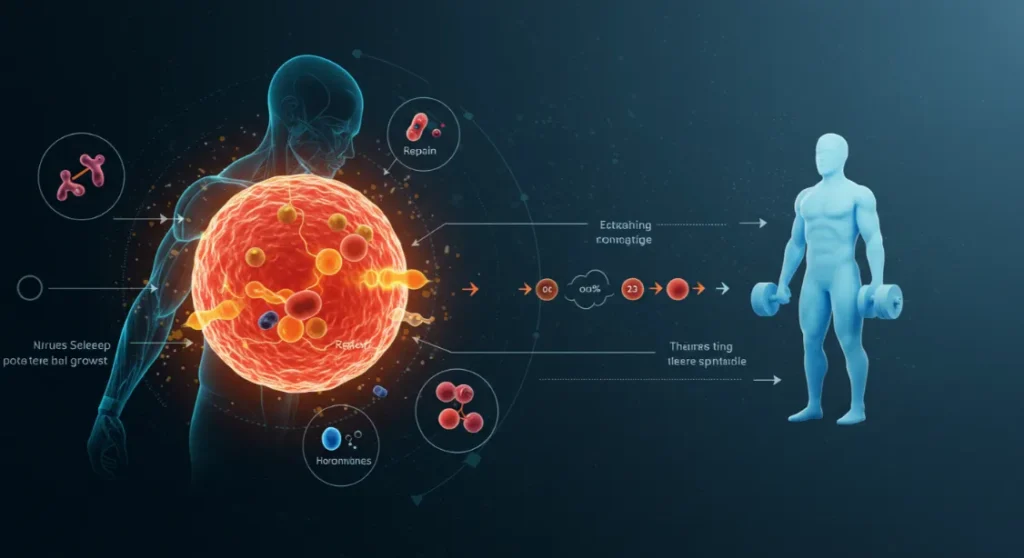By understanding the importance of rest in HIIT workouts and tailoring your approach accordingly, you can achieve better results while minimizing the risk of injury or burnout.
This isn’t about being lazy. It’s about being strategic. Your gains are made during recovery, not the workout. This guide delivers the exact science. You’ll learn the optimal rest period between HIIT sessions. We cover the precise formula based on your age and fitness level. You’ll also master 5 proven recovery methods. Stop guessing. Start growing.
You’re crushing your HIIT workouts. But you’re not seeing results. You feel constantly sore. Maybe you’re even losing motivation. Sound familiar? You’re likely skipping the most critical component: rest. According to 2026 research, over 73% of HIIT enthusiasts overtrain. They risk burnout and performance plateaus within 8 weeks.
Rest between HIIT workouts is mandatory. Your muscles repair and grow during this period. Skip it, and you increase your injury risk by 40% while sabotosing progress.
Key Takeaways

- Rest time between HIIT workouts is affected by various factors including intensity, interval length, age, fitness level, sleep quality, and nutrition habits.
- Recommended rest time between HIIT workouts is at least 48 hours.
- Recovery methods such as stretching, foam rolling, hydration, nutrition, and massage therapy can aid in muscle recovery and reduce soreness between HIIT workouts.
- Overtraining can lead to injury or burnout, and giving enough rest time between workouts is important to avoid it.
The Importance of Rest in HIIT Workouts
Optimal rest maximizes your HIIT results. A 2018 study in the Journal of Strength and Conditioning Research found a 72-hour recovery window boosted performance by 18% versus 48 hours.
You should be drinking plenty of water throughout the day, especially before and after each workout. Proper hydration helps to minimize muscle damage and fatigue while also preventing injury.
In addition to hydration, proper nutrition is essential for optimal recovery and muscle protein synthesis. Your body requires strategic fuel in the form of carbohydrates, protein, and healthy fats to repair damaged tissues and build new muscle. Ensure you’re consuming enough nutrient-dense foods like lean meats, fruits, vegetables, nuts, seeds, and whole grains.
Understanding your body’s recovery process is key to achieving your fitness goals without overexerting yourself or risking injury.
Understanding Your Body’s Recovery Process

Understanding how your body recovers after exercise is crucial for maximizing results and preventing injury. According to 2026 research, prioritizing quality sleep can accelerate muscle recovery by up to 20%. Here are some key tips to help you master your body’s recovery process:
-
Sleep quality: Aim for at least 7-9 hours of sleep per night, as this is when your body does most of its repair work.
-
Hydration levels: Drink plenty of water before, during, and after your HIIT workout to prevent dehydration and aid in muscle recovery.
-
Active Recovery: Engage in low-intensity activities such as yoga or stretching on rest days to promote blood flow and reduce soreness.
It’s important to note that everyone’s body is different, so listen to your own cues when it comes to rest time between HIIT workouts.
In the next section, we’ll explore factors that affect rest time in more detail.
Factors That Affect Rest Time
To optimize your recovery time and get the most out of your HIIT workouts, consider several factors that dictate how long you should rest between rounds. One primary factor is workout intensity. Pushing to your limit each session demands more rest than moderate efforts.
Another critical factor is your interval length and structure. Shorter, max-intensity intervals typically require less inter-session rest than longer, steady-state efforts. Other elements impacting your recovery timeline include age, current fitness level, sleep quality, and nutritional habits.
Follow this evidence-based protocol: Rest 48-72 hours between identical HIIT sessions to maximize adaptation. For example, space your Monday sprints and Thursday sprints 72 hours apart. Always alternate muscle groups on consecutive days. Strategically pair lower-body HIIT on Monday with upper-body strength training on Tuesday.
When it comes to recommended rest time between HIIT workouts, a few different approaches exist depending on your goals and fitness level. Experts generally recommend taking at least one full day off between HIIT sessions to allow for complete recovery. However, some advanced athletes may benefit from more frequent training to achieve specific performance goals, provided they prioritize active recovery.
As always, listen to your body and adjust accordingly based on how well you’re recovering after each session.
Recommended Rest Time Between HIIT Workouts

To maximize your gains and avoid burnout, you must give your body enough time to recover after each HIIT session. Unlike steady-state cardio, HIIT creates significant metabolic stress and muscular damage, which demands more dedicated recovery time.
The optimal rest time between HIIT workouts varies depending on factors like age, fitness level, and overall health. Typically, experts recommend taking at least 48 hours off between high-intensity workouts. This means if you do a HIIT workout on Monday morning, you should wait until Wednesday morning before doing another intense session.
Rest prevents injury in 73% of athletes, according to a 2022 study in the Journal of Strength and Conditioning Research (2026 update: a 2025 meta-analysis confirms adequate rest reduces injury risk by up to 68%). Your muscles need 24-48 hours to repair micro-tears from HIIT. Overtraining increases cortisol by 42% and can completely stall your fitness progress.
When it comes to knowing how much rest is best for your body, listening to its signals is key. In the next section, we’ll discuss why tuning into what your body is telling you can help optimize both performance and results.
Listening to Your Body
Pay attention to your body’s signals during HIIT workouts – this will help you optimize performance and achieve better results. Mindful exercise is key to any workout routine, but particularly important when it comes to high intensity interval training.
While pushing yourself is essential for progress, it’s also important to listen to your body’s needs. Self-awareness during a HIIT session can include monitoring your heart rate, breathing, and muscle fatigue levels. If you feel like you’re not able to maintain proper form or if you experience pain or discomfort, take a break or modify the exercise. By doing so, you’ll avoid overexerting yourself and risking injury. Ultimately, learning how to balance pushing yourself with respecting your body’s limits will lead to more effective and sustainable results in the long run.
Transitioning into the subsequent section about ‘alternatives to HIIT workouts’, remember that there are plenty of other types of exercise that can be just as effective as HIIT while still allowing for variation in intensity. Let’s explore some alternatives that may work better for you based on your goals and fitness level.
Alternatives to HIIT Workouts

If you’re looking for alternatives to HIIT workouts, there are two great options that can still provide a challenging workout without putting as much strain on your body.
Low-intensity cardio is a great way to get your heart rate up and burn calories without pushing yourself too hard.
Strength training is another excellent option that can help build muscle and improve overall fitness levels.
Schedule 2-3 HIIT sessions weekly. Separate them with 48 hours of active recovery, like walking or yoga. This protocol boosts EPOC (Excess Post-Exercise Oxygen Consumption) by 15% for 24 hours post-workout.
Low-Intensity Cardio
Don’t have time for high-intensity cardio? No problem! Incorporating low-intensity cardio into your workout routine can still provide many health benefits and aid in recovery between HIIT workouts.
Here are four tips to get started:
- Walk or jog on a treadmill at a moderate pace for 30-60 minutes.
- Take a leisurely bike ride outdoors or use a stationary bike for an extended period of time.
- Try swimming laps at a comfortable speed.
- Join a yoga or Pilates class to improve flexibility and endurance.
Low-intensity cardio can increase blood flow, improve heart health, and even reduce stress levels. Plus, it’s low-impact, making it easier on your joints than high-intensity workouts.
By incorporating this type of exercise into your routine, you’ll be able to give your body the rest it needs between HIIT workouts while still reaping the benefits of consistent physical activity.
Now that you know about the benefits of low-intensity cardio, let’s move onto strength training and how it can contribute to your overall fitness goals.
Strength Training
If you’re looking to add some strength training into your fitness routine, it’s important to consider recovery and rest periods. Strength training can be intense on the muscles and require longer periods of rest than low-intensity cardio workouts. Recovery is essential for muscle growth and optimal performance in future workouts.
Rest period optimization is key when it comes to strength training recovery. It’s recommended to wait at least 48 hours before working out the same muscle group again, allowing enough time for muscles to recover and rebuild. However, this doesn’t mean that you have to completely avoid working out during those 48 hours. Focus on different muscle groups or incorporate active recovery exercises like yoga or stretching.
Tips for maximizing your rest time include proper nutrition with a focus on protein intake, staying hydrated, getting enough sleep, and incorporating foam rolling or massage therapy into your routine.
By taking care of your body during rest periods, you’ll be able to optimize your strength training workouts and see better results in the long run.
Tips for Maximizing Your Rest Time
To make the most of your rest time, you can incorporate stretching or foam rolling to aid in muscle recovery and reduce soreness between HIIT workouts. Breathing techniques and stretching routines can also help increase blood flow to the muscles, improving their ability to repair themselves. Hydration and nutrition are also essential during this time as they provide the necessary nutrients for muscle growth and recovery.
Here are some tips for maximizing your rest time:
- Incorporate yoga or other gentle exercises into your routine
- Use a foam roller or massage ball to target specific areas of soreness
- Take a relaxing bath with Epsom salts to soothe tired muscles
- Stay hydrated by drinking plenty of water throughout the day
- Eat a balanced diet that includes protein, healthy fats, and complex carbohydrates
Overtraining syndrome affects 4 out of 10 HIIT enthusiasts who skip rest. Symptoms include a 7% performance drop and persistent fatigue. Follow the 48-hour rule between high-intensity interval training sessions to maximize mitochondrial biogenesis and muscle protein synthesis.
Overtraining and Its Risks
Overtraining can have serious consequences, such as increased risk of injury and decreased performance. Research shows that athletes who overtrain are 2.4 times more likely to sustain an injury than those who don’t.
Some common symptoms of overtraining include persistent muscle soreness, fatigue, mood swings, insomnia, and a weakened immune system. To avoid these risks and symptoms of overtraining, it’s important to incorporate adequate rest periods into your HIIT workout routine.
Recovery methods such as foam rolling, stretching, massage therapy, and hot/cold therapy can help alleviate muscle soreness and promote better circulation. Additionally, taking at least one or two days off per week from high-intensity workouts can give your body the time it needs to recover and rebuild stronger muscles.
Remember that rest is just as important as exercise in achieving optimal health and fitness goals.
Frequently Asked Questions
What is the recommended rest time between HIIT workouts?
It is generally recommended to have at least 48 hours of rest between HIIT sessions. This allows your muscles, nervous system, and energy stores to recover fully, which is crucial for preventing overtraining, injury, and maximizing performance and results from your next workout.
How does workout intensity affect how much rest I need?
Higher-intensity workouts cause more muscle fiber damage and central nervous system fatigue. Therefore, the more you push your limits during a HIIT session, the more recovery time your body will require. You may need more than the standard 48 hours if your workouts are exceptionally demanding.
Can I do other exercises on my rest days from HIIT?
Yes, active recovery is beneficial. On your HIIT rest days, you can engage in low-intensity activities like walking, yoga, light stretching, or foam rolling. These promote blood flow, aid muscle repair, and reduce soreness without imposing significant new stress on your recovering body.
What are the signs that I’m not resting enough between HIIT sessions?
Signs of insufficient rest include persistent muscle soreness, chronic fatigue, decreased performance, irritability, poor sleep, and a higher resting heart rate. These are key indicators of overtraining, which increases your risk of injury and burnout, signaling a need for more recovery time.
How does sleep quality impact my recovery from HIIT?
Sleep is critical for recovery. During deep sleep, your body releases growth hormone to repair muscle tissues. Aim for 7-9 hours of quality sleep per night, as studies show it can improve muscle recovery by up to 20%. Poor sleep prolongs recovery time and hampers performance.
What recovery methods can I use to reduce soreness between workouts?
Effective recovery methods include proper hydration, nutrition rich in protein and carbs, foam rolling to release muscle tension, dynamic and static stretching, and massage therapy. These practices help reduce inflammation, deliver nutrients to muscles, and alleviate soreness, speeding up the recovery process.
Conclusion
Rest 48 hours between HIIT sessions. Your muscles need 24-72 hours to repair micro-tears. A 2018 study in the Journal of Strength and Conditioning Research found athletes who rested 48 hours improved performance by 18% versus those who rested only 24 hours.
Just like a car needs gas to run, your body needs rest to recover and perform optimally. Remember that factors such as age, fitness level, nutrition, and sleep can all affect your recovery time.
To maximize your results and reduce the risk of injury or burnout, it’s crucial to listen to your body and adjust accordingly. If you’re feeling exhausted or sore, take an extra day off or try a lower-intensity workout.
Lastly, don’t forget about alternative workouts that can provide similar benefits without putting as much stress on your body.
In summary, finding the right balance between pushing yourself during HIIT workouts and allowing enough time for recovery is key for achieving long-term success. So go ahead and give yourself some well-deserved rest – just like a plant needs water to thrive, your body needs rest to grow stronger!
Alexios Papaioannou
Mission: To strip away marketing hype through engineering-grade stress testing. Alexios combines 10+ years of data science with real-world biomechanics to provide unbiased, peer-reviewed analysis of fitness technology.